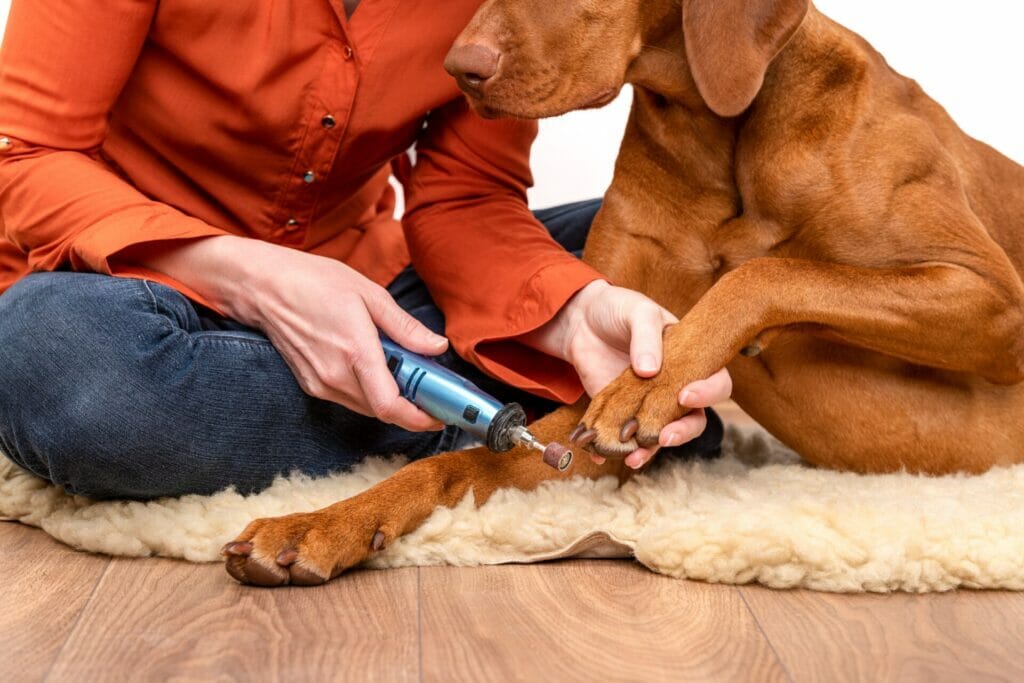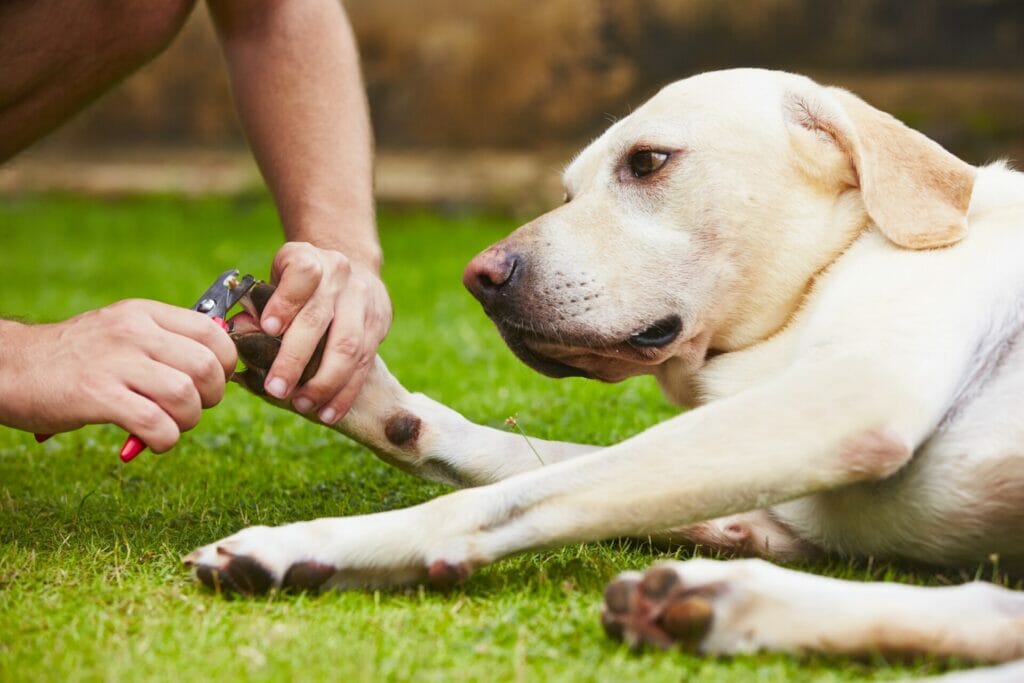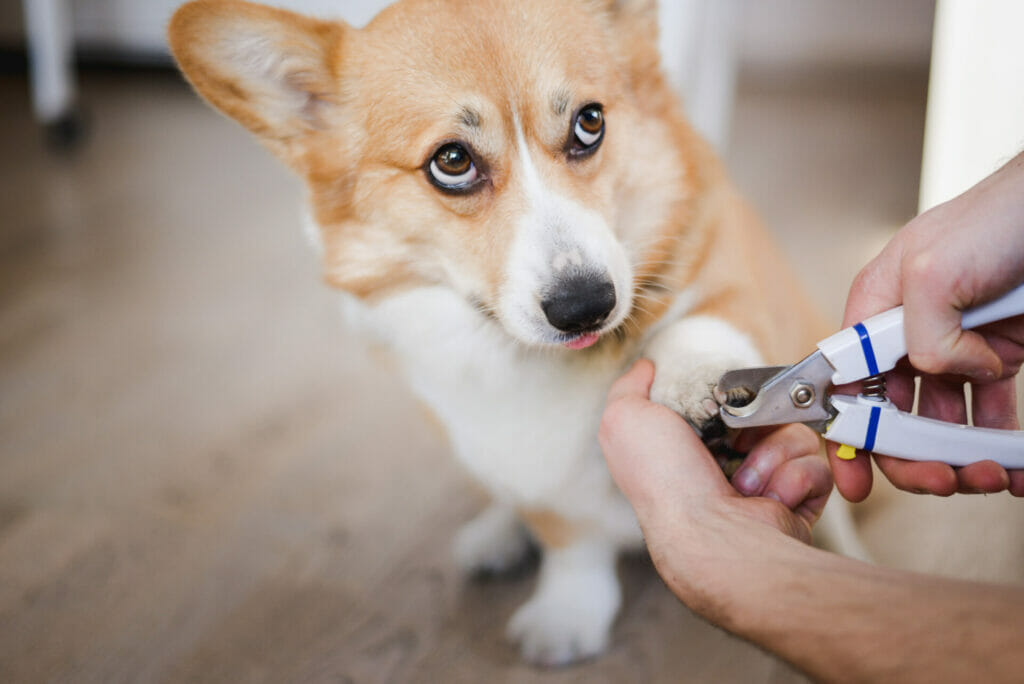Nail trimming’s probably your least favorite part of your dog’s grooming routine. Although sometimes stressful, it’s an important part of dog health. Nail trimming can be overwhelming but we’re here to help ensure your dog’s nails are in tip top shape. Below we’ll answer frequently asked questions about nail trimming.

Do I have to trim my dog’s nails?
All dogs, regardless of size and breed, need to have their nails trimmed on a regular basis. Trimming your dog’s nails is an important part of grooming. It’s best to expose your dog to the sensation of having their nails trimmed when they are young puppies. Dogs of any age, however, can learn to have positive associations with getting nails trimmed.
How frequently do I need to trim my dog’s nails?
Many dog owners wait too long between nail trims for their dogs. A dog’s nails should be trimmed on a regular basis to keep them short. At a minimum, a dog’s nails need to be trimmed monthly, but some dog owners prefer to trim their dog’s nails more frequently, even weekly. The more frequently you trim the less nail you need to take each session, making nail care easier for dogs and people. If your dog already has long nails, it’s best to increase the frequency of nail trims so that you can start to get their nails to a more appropriate length.
How long should a dog’s nails be?
A dog’s nails should be short, but not too short to avoid clipping the quick. The quick is a blood vessel that runs through your dog’s nail. A dog’s quick continues to grow with the length of the nail so if your dog’s nails are long, it may take some time to work its way down. When trimming light-colored nails, it’s the white strip you can see inside the nail. The longer your dog’s nails are, the longer the quick will grow. If cut, the quick will bleed. It’s important for your dog’s comfort to not cut into your dog’s quick when doing nails. A dog with nails of an ideal length should be able to walk on hardwood floors or other hard surfaces without their nails making clicking sounds.
What should I use to trim my dog’s nails?
The best tools depend on your dog’s preferences and what’s easiest for you. There are a variety of different kinds of nail clippers available for dogs. It’s important to select clippers that are the right size for your dog. Clippers that are too large can be frightening to dogs and make it hard to trim a small end of the nail. Clippers that are too small can pinch or even crack your dog’s nails. Another option for keeping your dog’s nails well-trimmed is to use a dog-nail Dremel which gently grinds down your dog’s nails. The Dremel creates a smooth edge on your dog’s nails which is an extra bonus. Regardless of the method used to trim your dog’s nails, it’s helpful to have styptic powder on hand to stop bleeding, if you accidentally cut the nails too short.

What are dewclaws and do they need to be trimmed?
Most dogs have dewclaws on their front paws, and a few breeds also have dewclaws on their rear legs. Dewclaws almost look like thumbs; they are the fifth-digit paw pads and nails. dewclaws help to give dogs extra traction while they are running and turning. Many dogs also utilize their dew claws to help hold or position toys and chews when laying down. When trimming your dog’s nails don’t forget about those dewclaws! If left untrimmed, dewclaws can easily grow in circular directions and even grow into your dog’s paw pads.
What happens if a dog’s nails aren’t trimmed?
Keeping your dog’s nails trimmed short isn’t just a cosmetic part of grooming. When a dog’s nails grow too long, discomfort and orthopedic problems can result. Dogs with long nails have less traction when walking on hard surfaces, which can lead to slipping. Walking on long nails over time can even change the way a dog walks. Eventually, it can even lead to conditions like arthritis and an increase in pain and discomfort. Long nails can also get caught on carpets and blankets which can lead to painful toenail ripping.
What if my dog hates getting their nails trimmed?
Nail trimming can be stressful for dogs and people. If your dog hates having their nails trimmed it’s important to go back to basics. Try reintroducing them to nail trimming in a gentle and positive way. Instead of trying to do all your dog’s nails in one sitting, start with one nail at a time. Pair nail trimming with high-value treats. To start, reward your dog when they let you hold a paw. Then gradually work towards clipping a nail (and continue the rewards). You can also give your dog peanut butter or wet food spread onto a lick mat or slow-feed dish as you trim nails. This can give your dog something high-value to focus on while you do their nails.
Can someone help me trim my dog’s nails?
If you are nervous about trimming your dog’s nails at home, you can always get professional support. Most veterinary clinics are happy to make a short “technician appointment” to trim a dog’s nails. Similarly, you can make an appointment at a local dog groomer just for a nail trim appointment. A skilled professional trims dog nails quickly and is less likely to accidentally cut the quick on your dog’s nails. This can be helpful with getting your nails down to a healthy short length.
Regular nail trimming is essential for the health and comfort of your dog. A dog’s nails should be trimmed at least once a month, but more frequently for some dogs. For example: dogs whose nails grow quickly or if you’re working on getting your dog’s nails back to an appropriate short length. Keep nail trimming a positive experience for your dog by pairing nail trims with lots of treats and keep training sessions short. Keeping your dog’s nails short will help to keep your pup looking and feeling their best.




















